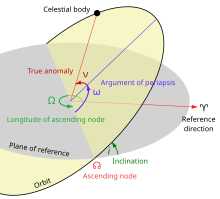
Back مستوى مداري Arabic Pla orbital Catalan Oběžná rovina Czech Baneplan Danish Bahnebene German Plano orbital Spanish صفحه مداری Persian Plano orbital Galician कक्षीय तल (खगोलशास्त्र) Hindi Bidang orbit (astronomi) ID


The orbital plane of a revolving body is the geometric plane in which its orbit lies. Three non-collinear points in space suffice to determine an orbital plane. A common example would be the positions of the centers of a massive body (host) and of an orbiting celestial body at two different times/points of its orbit.
The orbital plane is defined in relation to a reference plane by two parameters: inclination (i) and longitude of the ascending node (Ω).
By definition, the reference plane for the Solar System is usually considered to be Earth's orbital plane, which defines the ecliptic, the circular path on the celestial sphere that the Sun appears to follow over the course of a year.
In other cases, for instance a moon or artificial satellite orbiting another planet, it is convenient to define the inclination of the Moon's orbit as the angle between its orbital plane and the planet's equatorial plane.
The coordinate system defined that uses the orbital plane as the plane is known as the perifocal coordinate system.
